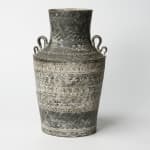Yasuhara Kimei 安原喜明 1906-1980
H30.4 x Dia17.7 cm
Further images
-
(View a larger image of thumbnail 1
)

-
(View a larger image of thumbnail 2
)

-
(View a larger image of thumbnail 3
)

-
(View a larger image of thumbnail 4
)

-
(View a larger image of thumbnail 5
)

-
(View a larger image of thumbnail 6
)

-
(View a larger image of thumbnail 7
)

-
(View a larger image of thumbnail 8
)

-
(View a larger image of thumbnail 9
)

-
(View a larger image of thumbnail 10
)

-
(View a larger image of thumbnail 11
)

Yasuhara Kimei, also known as Yasuhara Yoshiaki, was born in Tokyo in 1906. He was one of Japan's most avant-garde ceramic artists of his time. Famous for his stoneware "炻器 Sekki" ceramic works such as this flower jar, he conceptualized the "Object Vase", or "vase as an art object", which had an influence that transcended the world ceramics alone.
To create these "Sekki" works, which were formally inspired by archaeological Sue ware forms, Yasuhara used a combination of red Seto and Shigaraki clays, which when mixed with ground feldspar, iron oxide and cobalt, produced a distinctive dark surface. Yasuhara utilized a diversity of tools to create his unique designs including, bamboo spatulas, nails, saws and stamps. The techniques applied to create these vessels and the artistic vocabulary displayed on many of the works shown in this catalogue and exhibition are emblematic of the myriad influences on early twentieth-century Japanese ceramicists, who strived to define themselves as individual artists and ceramics as a path for personal expression. Like his contemporaries, Yasuhara was inspired by the technical virtuosity and unique surface decoration of historical ceramics created in China and Korea, as well as contemporaneous European artists.
Growing up in Tokyo, his father was a sailor on a foreign route. Although he was not physically strong, he loved art from an early age and learned drawing and painting in his teens. In 1924, at his father's urging, he studied pottery making techniques under Miyagawa Kozan II (1842-1916) in Yokohama, and around 1927, he studied under Itaya Hazan (1872 – 1963), learning how to be an individual ceramic artist.
It is important to note that Yasuhara learned from two master ceramic craftsmen at the start of his pottery career. Miyagawa Kozan II inherited the Makazu kiln, which had been in operation since the Meiji period (1868-1912), and was the master of a large pottery workshop with over 100 craftsmen, and was well versed in various ceramic techniques. On the other hand, Itaya Hazan, like Tomimoto Kenkichi (1886– 1963) and Kusube Yaichi (1897–1984), was a pioneer of individual ceramic artists in the 20th century, who studied "creativity" at art school and established himself as an artist by exhibiting his works at exhibitions.
This means that Yasuhara was able to learn from the most talented ceramic artists of his time the necessary requirements for a ceramic artist: a broad range of traditional ceramic techniques and authorship (creativity). Yasuhara's later work in an extremely wide range of techniques, including pottery, porcelain, and stoneware (especially glazed, non-glazed, inlaid, and painted porcelain), and the development of his own expression using these techniques, were based on the knowledge and teachings he had learned from Kozan and Hazan from the beginning of his pottery making career.
Throughout his career Yasuhara was a regular contributor to national exhibitions of first the Bunten and later Nitten. In the post-war years his ceramics were exhibited across the world, including in exhibitions throughout Europe.










